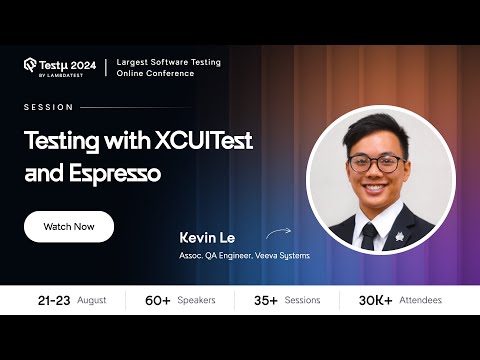Join Kevin Le as he explores mobile testing with XCUITest and Espresso. Learn about their integration with LambdaTest for scalable cloud testing, architectural design for robust test suites, and real-world implementation insights.
Still not registered? Grab your free ticket now!
Already registered? Share your questions in the thread below 
Hi there,
If you couldn’t catch the session live, don’t worry! You can watch the recording here:
Here are some of the Q&As from this session:
What strategies can be used to ensure consistent test results across different devices and OS versions when using LambdaTest with XCUITest and Espresso?
kevin Le: To ensure consistent results, standardize your test environment settings, including device configurations and OS versions. Use LambdaTest’s cross-browser testing capabilities to run tests on a variety of devices and OS versions, and leverage their automation scripts to maintain consistency in test execution.
We are leveraging XCUITest for testing iOS applications. Can you please let us know how easy or difficult it is to migrate to a platform like LambdaTest
kevin Le: Migrating to LambdaTest with XCUITest is relatively straightforward. LambdaTest provides comprehensive documentation and support for integrating XCUITest. You can configure your existing test scripts to run on LambdaTest’s cloud platform with minimal adjustments, focusing on adapting your configuration files and environment settings.
What technical debt with testing may be involved with using native frameworks vs. Appium?
kevin Le: Native frameworks often offer better performance and more robust integrations with platform-specific features but can lead to technical debt due to their lack of cross-platform support and the need for separate codebases. Appium provides cross-platform capabilities, which can reduce technical debt by allowing you to write tests once and run them across multiple platforms, though it may introduce complexity in managing various integrations and dependencies.
Here are some Unanswered Questions of this session
How can LambdaTest’s cloud infrastructure help in managing device fragmentation and ensuring comprehensive mobile test coverage?
Could you please share any GitHub repositories that we can refer to for mobile testing frameworks using XCUITest and Espresso?
What’s the best practices with XCUITest and Expresso?
In which architecture decision could we bring this up?
How can we achieve CICD for apps in lower environment?
To implement CI/CD for apps in a lower environment (such as development or staging), follow these steps:
-
Automated Builds: Use a CI tool like Jenkins, GitLab, or GitHub Actions to automate the build process every time a developer pushes code to the repository.
-
Test Automation Integration: Integrate XCUITest and Espresso into the CI pipeline to run automated tests. This ensures that all changes are tested before being deployed to production.
-
Environment Management: Use environment variables or config files to ensure tests are adaptable across multiple environments (dev, staging, prod). This allows the CI/CD pipeline to be flexible when deploying to lower environments.
-
Parallel Testing: Leverage LambdaTest’s parallel execution capabilities to run tests on multiple devices and configurations simultaneously, ensuring that tests are comprehensive and completed quickly.
-
Feedback Loop: Establish a fast feedback loop by notifying developers of test results immediately through tools like Slack or email, allowing for rapid fixes and faster delivery to production environments.
Here is the Answer:-
Answer:- Best practices for XCUITest and Espresso involve several key considerations to ensure reliable, maintainable, and scalable test automation. Some best practices include:
-
Test Atomicity: Ensure that each test case is independent and can run in isolation. This is critical in CI/CD environments.
-
Page Object Model (POM): Implement the Page Object Model to separate the test logic from UI interaction logic, making tests easier to maintain.
-
Parallel Execution: Utilize LambdaTest’s parallel testing capabilities to run multiple tests concurrently, reducing feedback time and allowing for faster releases.
-
Integration with CI/CD: Integrate XCUITest and Espresso with your CI/CD pipeline to ensure automated testing occurs with every code change. This can be done using popular tools like Jenkins, GitHub Actions, or CircleCI.
There are several GitHub repositories where you can explore mobile testing frameworks for XCUITest and Espresso. Some popular ones include:
-
XCUITest:
- [XCUITest Sample]- Provides an example of using XCUITest with Appium for iOS testing.
- [XCUITest Example Project] - A simple project showing how to integrate XCUITest for iOS apps.
-
Espresso:
- [Espresso Samples] - A comprehensive collection of Espresso testing samples by Google.
- [Espresso Example] - Includes examples of Espresso tests for Android apps.
These repositories serve as great starting points for understanding the structure and integration of these mobile testing frameworks.
Answer:-
LambdaTest’s cloud infrastructure offers scalable access to a wide range of real devices, enabling testers to overcome the challenge of device fragmentation in mobile testing. Device fragmentation refers to the diversity of mobile devices in terms of operating systems, screen sizes, hardware capabilities, and versions. By leveraging LambdaTest’s cloud infrastructure, teams can run tests on thousands of real iOS and Android devices, ensuring comprehensive coverage across different device models and configurations. This eliminates the need to maintain an in-house device lab, reducing cost and complexity. Furthermore, the cloud platform’s parallel testing capabilities allow teams to run multiple test cases simultaneously, speeding up the feedback cycle while ensuring consistent results across fragmented devices.
![]()

